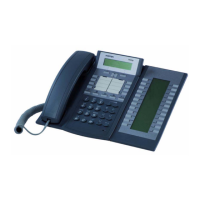IP PHONE FOR MX-ONE™
23 6/1553-DBC 434 01 Uen C 2010-12-17
2.8 Tones and Signals
It is possible to set different ring signals on the phone. For a description
on how to change signals, see 13.3.1 Changing Ring Signals for
Incoming Calls on page 96. To distinguish between different call types,
that is, internal, external and callback calls, the signal you choose is
used with different ring cadences, see 2.8.1 Call Type Characteristics on
page 23. It is also possible to distinguish between callers by assigning
contacts their own ring signal, see 8.3 Editing a Contact on page 66.
One other option is to use a melody instead of the ring signal, see
13.3.1.1 Downloading Melodies on page 97.
2.8.1 Call Type Characteristics
The ring signal for incoming calls alert in three different ways depending
on the type of incoming call. The signals shown in this section are the
most used signals worldwide. Many markets use signals that are
adapted for the local standards. If you get a signal that is not described
or you cannot identify, ask the system administrator.
Note: At a second incoming call, the phone rings only the first period
and with a low level by default. The alerting type can be changed,
see 13.3.2 Alert Type on page 97. This is valid for both the
internal and external ring signal.
Internal ring signal
External ring signal
Recall signal (Callback reminder)
If a melody is used instead of the ring signal, there is no difference
between internal and external calls. The callback signal cannot be a
melody, the default ring signal number 5, is used instead.
2.8.1.1 Ringing Volume
Use the Volume keys to adjust the ring volume. The new volume setting
is stored.

